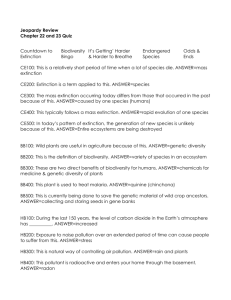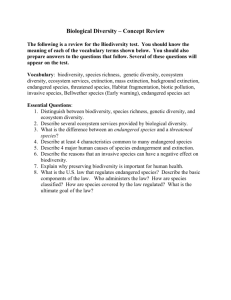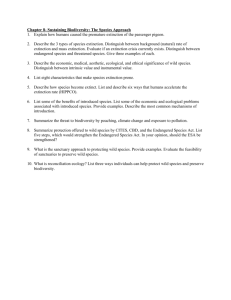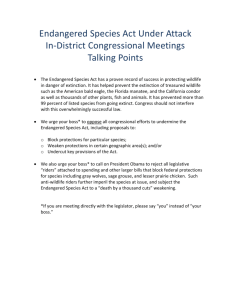Chapter 11 - TeacherWeb
advertisement
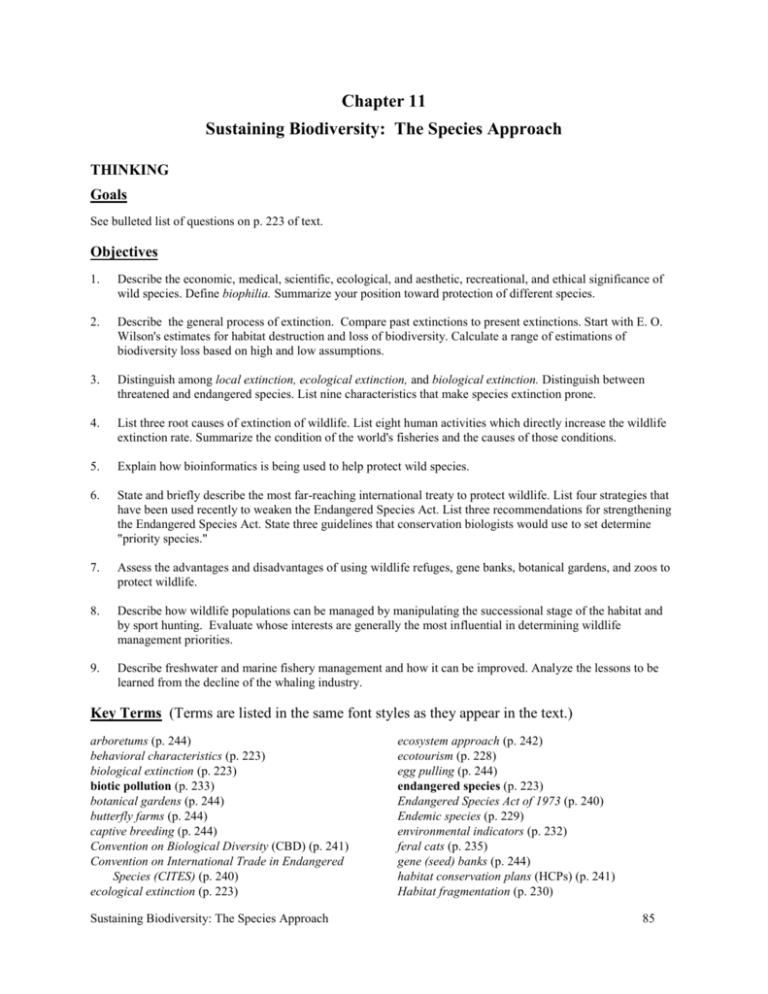
Chapter 11 Sustaining Biodiversity: The Species Approach THINKING Goals See bulleted list of questions on p. 223 of text. Objectives 1. Describe the economic, medical, scientific, ecological, and aesthetic, recreational, and ethical significance of wild species. Define biophilia. Summarize your position toward protection of different species. 2. Describe the general process of extinction. Compare past extinctions to present extinctions. Start with E. O. Wilson's estimates for habitat destruction and loss of biodiversity. Calculate a range of estimations of biodiversity loss based on high and low assumptions. 3. Distinguish among local extinction, ecological extinction, and biological extinction. Distinguish between threatened and endangered species. List nine characteristics that make species extinction prone. 4. List three root causes of extinction of wildlife. List eight human activities which directly increase the wildlife extinction rate. Summarize the condition of the world's fisheries and the causes of those conditions. 5. Explain how bioinformatics is being used to help protect wild species. 6. State and briefly describe the most far-reaching international treaty to protect wildlife. List four strategies that have been used recently to weaken the Endangered Species Act. List three recommendations for strengthening the Endangered Species Act. State three guidelines that conservation biologists would use to set determine "priority species." 7. Assess the advantages and disadvantages of using wildlife refuges, gene banks, botanical gardens, and zoos to protect wildlife. 8. Describe how wildlife populations can be managed by manipulating the successional stage of the habitat and by sport hunting. Evaluate whose interests are generally the most influential in determining wildlife management priorities. 9. Describe freshwater and marine fishery management and how it can be improved. Analyze the lessons to be learned from the decline of the whaling industry. Key Terms (Terms are listed in the same font styles as they appear in the text.) arboretums (p. 244) behavioral characteristics (p. 223) biological extinction (p. 223) biotic pollution (p. 233) botanical gardens (p. 244) butterfly farms (p. 244) captive breeding (p. 244) Convention on Biological Diversity (CBD) (p. 241) Convention on International Trade in Endangered Species (CITES) (p. 240) ecological extinction (p. 223) Sustaining Biodiversity: The Species Approach ecosystem approach (p. 242) ecotourism (p. 228) egg pulling (p. 244) endangered species (p. 223) Endangered Species Act of 1973 (p. 240) Endemic species (p. 229) environmental indicators (p. 232) feral cats (p. 235) gene (seed) banks (p. 244) habitat conservation plans (HCPs) (p. 241) Habitat fragmentation (p. 230) 85 Habitat island (p. 230) HIPPO (p. 229) hot spots (p. 226) instrumental value (p. 227) intrinsic (existence) value (p. 228) kudzu vine (p. 233) local extinction (p. 223) microorganisms (p. 229) outdoor pet cats (p. 235) Precautionary approach (p. 236) reconciliation ecology (p. 245) red lists (p. 225) safe harbor agreements (p. 241) speciation crisis (p. 227) Species (CITES) (p. 240) species-area relationship (p. 225) theory of island biogeography (p. 225) threatened (vulnerable) species (p. 223) voluntary candidate conservation agreements (p. 242) wild (feral) boars (p. 235) Outline Species Extinction The three levels of species extinction are local, ecological, and biological. A. Local extinction occurs when a species disappears from an area in which it once inhabited but is found elsewhere in the world. B. Ecological extinction occurs when the number of members of a particular species is so low that they cannot fulfill their ecological roles in their biological communities. C. Biological extinction occurs when a species has disappeared from the earth. D. Species heading toward biological extinction are either endangered or threatened. 1. Endangered species are so few in number that the species could soon become extinct over all or part of its natural range. 2. Threatened/vulnerable species is still abundant in its natural range but because of loss in numbers is likely to become endangered in the near future. 3. The first species to go tend to be the big, the slow and the tasty ones—ones whose valuable parts can be sold. 4. The passenger pigeon represents lost natural capital, primarily because of overhunting and habitat destruction directly attributable to man. 5. A survey in 2000 found that about one-third of 21,000 animal and plant species in the U.S. are vulnerable to premature extinction. E. Biologists use measurements and models to estimate extinction rates. 1. Background extinction, mass extinctions, and mass depletions account for a loss of 99.9% of all species that have ever existed. 2. Extinction spasm describes the loss of a large number of species within a few centuries. 3. Predicting extinctions is always difficult because of three factors. a. Extinction usually takes a long time and is difficult to document/prove. b. A small percentage of the world’s species have even been identified. c. We know very little about most of the world’s identified species. 4. Various methods are used to estimate extinction rates. a. One approach is to study past records documenting extinction since man came on the scene. b. The World Conservation Union as kept Red Lists that are the world standard for listing all threatened species throughout the world. They provide baseline information on change in biodiversity over time. c. Define the number of species’ increase as the size of an area increases (species-area relationship). d. When an area decreases by 90%, about 50% of the species there become extinct. e. Use models to estimate a species extinction risk by predicting population size, habitat changes/availability, and species interaction. f. Estimates of future extinction vary due to different assumptions about total species number, the proportion found in the tropics, rate of clearance of tropics, reliability of methods. 5. Human activities affect extinction rates. a. Currently, the rate of extinction is estimated to be 1,000-10,000 times the rate before mankind existed. 86 Instructor's Manual: Chapter 11 b. Using estimated extinction rates, 20% of the world’s present plant and animal species will be gone by 2030; 50% would vanish by 2099. 6. Greater extinction rates than predicted are likely because of several factors. a. Species loss and biodiversity loss will likely increase because of exponential population growth. b. Biologically diverse areas (hot spots) rate of extinction may be as high as 25-50%. The extinction rate in these ‘hot spots’ deserves special attention. c. Possible colonization sites for new species are being eliminated, degraded and simplified by human activities so that new species cannot arise. By reducing this rate of speciation, we are creating a speciation crisis. Such a crisis may contribute to dominance of the world by species with survival power—cockroaches, rats and weeds— and contribute to the permanent decline of earth’s variety of species and habitats. d. A precautionary strategy to prevent a significant decrease in the genetic, species, ecological, and functional diversity of the earth is necessary. Importance of Wild Species Wild species have value—economic and ecological—which are important to the earth. A. We are destroying species biodiversity more quickly than new species can evolve. It will take 5 million years for speciation to rebuild the animals and plants we will destroy in 100 years. We should preserve species for their instrumental value. B. Some of the economic and ecological benefits of present species have not even been identified; we are destroying our chance for a future. 1. Medicinal properties are found in many plants and some animals. 2. Genetic information in species helps them adapt and produce new species. This information can be used to develop food and medicines for people. Wild species provide a bank of genetic information. 3. Recreational value is provided by plants and animals. 4. Eco-tourism generates money to help poor countries; preserving plants and animals is much more economically wise than destroying them. a. A male lion skin is worth $1,000; a male lion living for 7 years produces $515,000 in tourist dollars. b. Bats, often targeted for destruction by man, feed on crop-damaging insects, and pollinate flowers, as well as distribute plants by excreting undigested seeds. Bats are keystone species in the tropics. C. Some people would protect some species, not necessarily all of them. Others believe that every species has intrinsic value, the right to exist, and should be free from human interference. D. We must remember that all species, including microorganism have important roles to play in keeping ecosystems in balance. Habitat Loss, Degradation, and Fragmentation There are several causes of depletion and premature extinction of wild plants and animals. The acronym HIPPO describes these causes. A. The loss, degradation, and fragmentation of habitat are the greatest threat to a species. 1. Deforestation in tropical forests is the greatest species eliminator followed by loss of wetlands and plowing of grasslands. 2. Temperate biomes have been compromised by widespread development over the last 200 years. Emphasis is now shifting to the tropics. 3. Major habitat disturbance factors are, in order of importance, agriculture, commercial development, water development, outdoor recreation, livestock grazing, and pollution. 4. Endemic species are those found nowhere else on earth and are often found in island habitats. Habitat islands are a habitat surrounded by a different one, such as a national park surround by logging, mining, etc. activities. a. Habitat fragmentation leads to species vulnerability to predators, disease, etc. b. Species are limited in their ability to colonize new areas, find mates and food. 5. Approximately 70% of the world’s known species of birds are declining in numbers and one in six species is threatened with extinction due to habitat loss and fragmentation. Nonnative species are the 2nd greatest threat to birds 6. Birds are excellent environmental indicators because they live in every climate and biome, respond quickly to environmental changes in their habitats, and are easy to track and count. Sustaining Biodiversity: The Species Approach 87 7. Birds have important ecological roles such as helping to control rodents and insects, pollination of flowering plants, seed dispersal, and as scavengers of dead animals. Invasive Species A Many nonnative species provide us with food, medicine and other benefits, but some replace native species, disrupt ecosystems and cause large economic losses. B. Invasion of alien species leads to extinction. Nonnative species introduction into an ecosystem can destroy it. 1. The alien species can be introduced accidentally or deliberately. 2. Some of these species threaten and endanger native species. a. They have no natural predators, competitors, or pathogens in their new habitat. b. They can trigger ecological disruptions, such as the wild African honeybee or the Formosan termite. c. Feral pigs were deliberately introduced and cause all sorts of damage. Feral cats and domestic cats kill about 568 million birds per year. d. Kudzu was deliberately introduced in the 1930’s to control erosion, but got out of hand. There are indications now that it may be a good source of tree-free paper, and a Japanese company in Alabama processes kudzu for starch they ship to Japan. e. Argentina fire ants are an example of an extremely aggressive nonnative species that has eliminated about 90% of native ant species, caused widespread agricultural damage and become genetically resistant to pesticides through natural selection. 3. The best control is to prevent the nonnative species from being introduced. a. Identify the types of ecosystems that are vulnerable to invaders and identify the characteristics, which allow the nonnative species to become successful invaders. b. Inspect imported goods. c. Identify harmful invader species and pass international laws that prohibit their transfer from one country to another. Population Growth, Pollution, and Climate Change A. Overpopulation and excessive and wasteful consumption of resources have caused premature extinctions. B. Human activities may induce rapid climate changes, increasing extinction rates. Overexploitation Some protected species are killed for their valuable parts or are sold live to collectors. A. Smuggling wildlife –including many endangered species- is the 3rd largest and most profitable illegal crossborder smuggling activity after arms and drugs. B. At least 2/3rds of all live animals smuggled around the world die in transit. 1. Animals are worth a great deal each die to use of animal parts in the Middle East and China. 2. Tiger populations have declined drastically since 1950 mostly because of habitat loss and poaching for fur and bones. 3. Black market demand has increased as these animals have become endangered. 4. It also negatively impacts forest carnivores by depleting their main prey species. 5. The forest itself is changed by a decrease in seed-dispersing animals. C. People try to exterminate species that compete with them for food and game animals. D. U.S. government animal control agents kill thousands of coyotes, prairie dogs, wolves, bobcats and other species because they prey on livestock, game species or aquaculture ponds. 1. Ninety-nine percent of the prairie dogs in the U.S. have been eradicated. 2. The black-footed ferret is endangered because they preyed on the prairie dog and is another example of unintended consequences due to not understanding connections between species. E. Global legal and illegal trade in wild species for pets is a very profitable business. 1. More than 60 bird species, mostly parrots are endangered or threatened because of the wild bird trade. 2. Amphibians, reptiles, mammals and tropical fish are also being depleted because of pet trade. 3. Ex-poachers in Thailand are now making more money taking eco-tourists into the forest than they did by poaching hornbills. They also protect these birds from poachers. 4. Collecting exotic pets and plants (such as orchids and cacti) kill large numbers of them and endanger these species and others that depend on them. 88 Instructor's Manual: Chapter 11 F. Pollution from human activities undermines habitats and the lives of species. 1. Climate change threatens a number of species with extinction. a. Global warming will alter the world’s habitats. b. Species may not have enough time to adapt to the climate change and will die. 2. Pollution underminds all living species. a. Chemicals degrade the environment and kill species. b. Pesticides are especially deadly to honeybees, birds, and fish. G. Bushmeat supplies indigenous people with food and has been harvested sustainably, but as demand has gone up illegal hunting has skyrocketed. 1. There has been an eightfold increase in Africa’s population. 2. Logging roads allowed ranchers, miners and settlers into areas once too remote/inaccessible. 3. Restaurants in many parts of the world serve bushmeat dishes. 4. People living in poverty use selling bushmeat to collectors, meat suppliers and poachers as a means of survival. 5. These hunting practices have resulted in negative ecological impacts and have driven at least one species to extinction. Protecting Wild Species: Legal and Economic Approaches A. Treaties help protect endangered and threatened species but enforcement is difficult and punishment inadequate. B. 1975 Convention on International Trade in Endangered Species (CITES) protects 900 species from being commercially traded and restricts international trade for 29,000 species that may become threatened. 1. Enforcement is difficult and varies from country to country. 2. Many countries are not signatories and still trade in animals. 3. Convention on Biological Diversity (CBD) binds governments to reverse the global decline in biological biodiversity. United States has not ratified this treaty. There are no severe penalties or other enforcement mechanisms in place. C. Laws help the U. S. control imports and exports of endangered wildlife and wildlife products. 1. Endangered Species Act of 1973 (ESA) identified and legally protects endangered species in the U. S. and abroad. a. Identification of endangered, threatened ocean species is made by the National Marine Fisheries Service, and the US. Fish and Wildlife Service is responsible for identifying and listing all other endangered and threatened species. b. Biological facts form the basis of inclusion on the endangered list. c. Habitats of endangered species must be protected. d. In 2003 Congress exempted the Defense Department from these protection acts. e. On private lands, fines and a possible one-year imprisonment can be used to protect the habitats of endangered species. This is controversial since many species are located totally or partially on private land. 2. A 2000 study by the Nature Conservancy found 1/3 of the U. S. species are at risk of extinction, and 15% are at high risk. 3. Critical habitats are supposed to be designated and protected by the ESA. Political pressure and lack of money has affected this directive. Although recovery plans have been approved for about 79% of endangered/threatened U. S. species, about half of them have not been implemented because of political pressure and lack of funds. 4. There is controversy over the ESA regarding political and legal issue of whether federal and state governments should compensate owners for decrease in financial value of property. 5. Efforts have been made to repeal/weaken the Endangered Species Act by: a. Some developers, timber companies and other private landowners avoid government regulations and loss of economic value by managing land to reduce its use by endangered species b. Congress changed the ESA in several ways to help deal with problems associated with the regulatory takings issue. c. Habitat conservation plans (HCPs) are designed to reach a compromise between interests of private landowners and endangered/threatened species. d. The HCP allows destruction of some critical habitat or killing of a population if the developer or landowner takes steps to protect that species using a series of steps such as protecting critical Sustaining Biodiversity: The Species Approach 89 D. E. F. G. nesting sites, setting aside pare of the habitat as protected land, maintaining travel corridors or moving the species to another suitable habitat, etc. 6. Two major criticisms of the HCPs are that many are approved without adequate scientific evaluation of their effects on the species, and that many are political compromises that do not protect the species or its recovery. 7. In 1999, USFWS approved two new approaches for protection of endangered/threatened species on private land. a. The safe harbor agreement has landowners voluntarily taking specified steps to restore, improve, or maintain habitat for the species. Landowners get technical help in return. b. Voluntary candidate conservation agreements are a second method where landowners agree to conserve a declining population not yet listed. In return the landowners receive technical help and assurances that no additional restrictions will be imposed on the land. Efforts have been made to repeal/weaken the Endangered Species Act by: 1. make protection of endangered species on private land voluntary. 2. have the government compensate private landowners who protect endangered species. 3. complicate the process to list newly endangered species. 4. Eliminate the need to designate critical habitats because the development and implementation of a recovery plans more important. 5. allow the Secretary of the Interior to allow a listed species to become extinct and to determine whether a species should be listed. 6. exempt any state, county, or landowner from the law. Conservation biologists believe that the ESA should be strengthened and modified to correct deficiencies. They contend that it has been a success because: 1. Species are listed only when they are in serious danger of extinction 2. It takes decades for most species to become endangered or threatened. 3. Most important, the condition of almost 40% of the listed species is stable or improving. 4. The federal endangered species budget was only $58 million in 2005, about what the Department of Defense spends in 11/2 hours The National Academy of Sciences recommended three major changes in order to make ESA more scientifically sound and effective: 1. greatly increase funding to implement the act 2. recovery plans be developed more quickly 3. when a species is first listed, establish a core of its survival habitat that could support the species for 2550 years. Most biologists believe the U.S. should modify the act to emphasize protection and maintenance of biological diversity and ecological functioning rather than try to save individual species. This new approach would follow three principals: 1. Learn what species and ecosystems the country has 2. Locate and protect the most endangered ecosystems and species within the systems 3. Put more emphasis on prevention of species becoming threatened and from degradation of ecosystems 4. Provide landowners who agree to help protect endangered systems with significant financial incentives, technical help Protecting Wild Species: The Sanctuary Approach The sanctuary approach is being used to protect wild species. A. 542 federal refuges protect wildlife but the habitats are deteriorating due to invasive species, pollutants, and little operational or maintenance funding. B. More than ¾ of the refuges are concentrated along major bird migration corridors. C. About 1/5th of U.S. endangered and threatened species have habitats in the refuge system. D. Human overuse by hunters, fishermen and off-road vehicle traffic has hurt the refuges. E. Gene banks, botanical gardens and farms can be used to raise threatened species and help protect species from extinction; but funding is inadequate. F. Raising some threatened or endangered species on farms can take some of the pressure off them and perhaps offer some for commercial sale. G. Zoos and aquariums can help protect some endangered animal species as well, but they are both notoriously underfunded. 90 Instructor's Manual: Chapter 11 1. Egg pulling collects wild eggs laid by endangered bird species and hatches them in zoos/research centers. 2. Captive breeding takes wild individuals into captivity for breeding with the commitment to re-introduce the offspring back into the wild. 3. Artificial insemination, use of surrogate mothers, use of incubators, and cross-fostering by a similar species are other ways to increase populations of rare species. 4. The ultimate goal is to reintroduce these species into the wild. H. Reintroductions of endangered species to the wild fail because: 1. There is not suitable habitat. 2. Individuals bred in captivity are not able to survive in the wild. 3. There is renewed overhunting/capture of the returned species. I. A large population of a species is needed to maintain the capacity for biological evolution. 10,000+ individuals are needed for such capacity. J. The major conservation role of zoos is to educate the public about species’ biological importance and the need to protect habitats. Zoos do not have the space to sustain the necessary numbers in an animal population. Reconciliation Ecology A. Michael L. Rosenzweig identifies the real challenge for biodiversity: to sustain wild species in the humandominated portion of nature. B. Rosenzweig advocates that we implement reconciliation ecology: learn to share the spaces we dominate with other species. It is the science of inventing, establishing and maintaining new habitats to conserve species diversity where people live out their lives. C. There are several ways to implement reconciliation ecology. 1. Maintain diverse yards using native plants, which attract certain species. 2. Share responsibility for supporting bio-diverse yards and gardens. 3. Apply reconciliation ecology to local plant and animal life: i. e. bluebirds project. 4. Planting rooftop gardens can support a variety of species, provide insulation, reduces evapotranspiration, conserves water and cools cities. 5. Golden Gate Park in San Francisco is a good example of reconciliation ecology; it was transformed from sand dunes to park by humans. 6. Government land, college campuses, and schools could be used for reconciliation ecology laboratories. Summary 1. Biologists estimate extinction rates in one of three levels. Local extinction occurs when a species in a specific area is lost but the species is still found in other places. Ecological extinction describes a species which is so small that it cannot play out its ecological role where it is found. Biological extinction means that the species is gone from the earth. Scientists use measurement and models to estimate extinction rates: studying past records, identifying species-area relationships, examining lists of threatened species. Extinction rates are increasing because of human activities. Our growing population, degrading and eliminating biological environments, biological hot spots undermining biodiversity all contribute to growing extinction rates. 2. Biodiversity and species extinction are important because they provide enormous economic and ecological services which we need to survive. In 100 years, mankind will destroy species which it would take 5 million years to rebuild. These species may provide genetic information, medicines, information about natural processes which we need to discover. These wild plants and animals are economic, recreational, and health resources. 3. Many human activities endanger wildlife, such as degradation/loss of habitat; capture of wild animals which prevents their breeding; overfishing, oil spills, and exposure to pesticides; extinction from nonnative species which we introduce. 4. To prevent premature extinction of species, we must reduce threats from nonnative species; end illegal poaching and hunting; provide means for people to survive economically without killing native animals for Sustaining Biodiversity: The Species Approach 91 food; maintain predator species, not destroy them; reduce greenhouse emissions and deforestation throughout the world; develop governmental policies to support biodiversity; protect wild species in sanctuaries. 5. Reconciliation ecology develops methods to share the places man dominates with other species. It can be use to invent, establish, and maintain new habitats to conserve species diversity. Safe harbor agreements and voluntary conservation agreements among communities can support reconciliation efforts. Everyone must take part to save the earth’s biodiversity—individuals, governments, corporations, and groups. More Depth: Conceptual Term Paper Topics 1. Significance of wildlife: medicines derived from plants and animals; commercial products from wildlife; aesthetic and recreational significance of wildlife; ecological significance of wildlife. 2. Endangered and threatened wildlife: tropical deforestation and species extinction; the international trade in endangered species and exotic pets; lead poisoning in waterfowl and the American bald eagle; Florida's alien species problem; the California condor; the Florida manatee; the blue whale; bats; rhinos; elephants. 3. Protecting wildlife: bioinformatics; gene banks; zoos and captive breeding programs; habitat management; artificial reef-building materials and methods. More Breadth: Interdisciplinary Activities and Projects 1. Are there zoos, aquariums, botanical gardens, or arboretums in your locale operating programs designed to increase the populations of endangered species? If so, invite a spokesperson to explain one or more of these programs to your class. 2. Ask your students to bring to class and share paintings, sketches, poetry, songs, and other artistic creations depicting the beauty and wonders of wildlife. 3. Have a game warden address your class about management of populations of fish and animals that are hunted for sport. Multisensory Learning: Audiovisuals Biodiversity: Alien Invaders: Invasive Species and the Threat to Biodiversity. 1998. 30 min. VHS/DVD. CE. Arkelope (endangered species). 1995. 5 min. BFF. Biodiversity: the variety of life. 1992. 42 min. BFF. Biodiversity: The Videotape; 45 min.; adapted from the 1986 National Forum on Biodiversity; NAP. Diversity Endangered; 1987; 10 min.; introduction to the meaning and importance of biological diversity; SITES. Our Threatened Heritage; 1987; 50 min.; political aspects and environmental consequences of tropical deforestation; NWF. Our Threatened Heritage; 1988; 19 min.; loss of biodiversity, deforestation, and climate change; VP. Remnants of Eden from Race to Save the Planet; 1990; 60 min.; growing human populations and biodiversity; ACPB. The Shaman’s Apprentice. 2001. 54 min. BFF. Wildlife Conservation Strategies: Farmscaping: Advanced Tactics for Achieving Sustainability. 27 min. VP. Amazonia: A Burning Question; 1987; 58 min.; Dr. Thomas Lovejoy describes efforts to understand and conserve the rain forest; SUNY. Conservation of the Southern Rainforest; 1988; 60 min.; scientists, conservationists, native healers work together exploring alternative solutions for preserving the forest; BF. 92 Instructor's Manual: Chapter 11 In Celebration of America's Wildlife; 1987; 57 min.; how U.S. wildlife is being restored; CF. Landscape Linkages; 1988; 25 min.; wildlife photography and computer graphics explain the corridor approach to wildlife conservation; FF. Mooselift: A Reintroduction of Moose to Michigan's Upper Peninsula; 1987; 15 min.; documentary of the international cooperative effort to restore moose to Michigan; MDNR. Return from Forever; 1987; 30 min.; re-establishment of a breeding population of osprey in Pennsylvania; WRCF. Serving Time (The Nature of Things); 1987; 47 min.; zoos maintaining genetic variation in captive species; FI. On Nature’s Terms. 2001. 25 min. BFF. Our Vanishing Forests. 1993. 58 min. BFF. Wildlife for Sale: dead or alive. 1998. 47 min. 2 parts. BFF. Individual Wildlife Species: Life of Mammals. 4 parts. VHS/DVS. PBS. Lolita: Slave to Entertainment. 2002. 60 min. DVD. GPF. Wolf: an Ancient Spirit Returns. 2004. 45 mins. BFF. Cane Toads, An Unnatural History; 1988; 46 min.; wildly entertaining film about the importation of 102 cane toads into Australia; FRF. Farewell, Ancient Mariner; 1988; 25 min.; plight of endangered sea turtles; OFP. On the Edge of Extinction: Panthers and Cheetahs; 1987; 48 min.; attempts to save these breeds' habitats; deals with genetic variation, human overpopulation and interference; WETA. Realm of the Alligator; 1986; 60 min.; the Okefenokee swamp, home of the alligator; NG. Sharks: Predators or Prey?; 1992; 20 min.; a fascinating look at shark behavior and the ecological niche filled by sharks, dispelling many popular myths; VP. Shorebirds—A Rite of Spring; 1986; 28 min.; Delaware Bay and shorebird migration; NJN. Spirit of the Eagle; 1991; 30 min.; VP. The Bats of Carlsbad; 1986; 5 min.; bat flights; NAVC. The Elephant Seal: Living on the Edge of Extinction; 14 min.; genetic diversity; BFF. Where Have All the Dolphins Gone?; 1991; 58 min.; VP. Woodstork: Barometer of the Everglades; 58 min.; a National Audubon Society film looking at the woodstork as an indicator species; FA. World of Audubon: Grizzlies & Man: An Uneasy Truce; 1988; 48 min.; from invincible creature to threatened species; TBS. World of Audubon: Messages from the Birds; 1988; 48 min.; shorebirds as indicator species; TBS. ATTITUDES/VALUES Assessment 1. Do you believe that humans have a duty to subdue wild nature to provide food and other basic needs for people and to provide jobs and income through increased economic growth? 2. Do you believe that every living species has a right to exist, or at least struggle to exist, simply because it exists? 3. Do you believe that we have an obligation to leave Earth for future generations of humans and other species in as good a shape as we found it, if not better? Did past generations do this for you? More Depth: Discussion and Term Paper Topics 1. Should animals be used for medical research? As sources of organs for surgical implants in humans? As sources of food, fur, fat, oils, and other commercially valuable products? Sustaining Biodiversity: The Species Approach 93 2. Are extremist tactics by Greenpeace necessary or justifiable? 3. Should sport hunting be used as a wildlife management tool? 4. Should limits be placed on genetic engineering for economic, aesthetic, ecosystem services, or other purposes? 5. The Endangered Species Act: Success or Failure? 6. Should we privatize fishing rights in the United States? 7. Should we lift the international ban on whaling? (Also, see text, Critical Thinking, p. 247 and Critical Thinking and the Environment.) PARTICIPATION Lifestyle and Campus Community See Green Lives/Green Campuses, Chapter 9: Wildlife: Plants and Animals. More Depth: Action-oriented Term Paper Topics 1. Individuals: scientific estimation of wildlife populations and successional stages. 2. Groups: Ducks Unlimited; the National Wildlife Federation; the Audubon Society; Greenpeace; Earth First! 3. National: America's National Wildlife Refuge System. 4. Global: the World Wildlife Fund. SKILLS Environmental Problem-Solving Skills: Projects 1. Compile a list of the fish and wildlife species in your locale that have been officially designated as threatened or endangered. As a class project, find out what specific actions are being taken to assist these species. 2. As a class, examine and evaluate the goals of the World Conservation Strategy. Develop objectives that could help implement the goals that are agreed upon by the class. 3. If there are rangelands in your locale, try to schedule a class visit to examples of well- and poorly managed grazing lands. Compare the quantity and quality of vegetation present. 4. If possible, visit projects restoring prairie lands to a more natural state. Investigate how local citizens are participating in these programs and how they are progressing. Laboratory Skills (none) Computer Skills Biological and Conservation Data (BCD) System -An inexpensive, effective tool to inventory, rank, and protect endangered species. -The Nature Conservancy, Data Systems Div., 1815 North Lynn Street, Rosslyn, VA 22209 94 Instructor's Manual: Chapter 11 *Audubon Wildlife Adventures -Explore wildlife conservation issues of grizzlies and whales using scientific information, state-of-the-art graphics, computerized data bases, and on-line guidebooks. -Advanced Ideas, Inc., 591 Redwood Highway, #2325, Mill Valley, CA 94941 (415-388-2430) *Wildways: Understanding Wildlife Conservation -Emphasizes the need for wildlife conservation through integration of biology, geology, and sociology in sections on Earth and life, basic necessities of life, importance of wildlife, population and community ecology, extinction, wildlife management, and citizen action. -Opportunities in Science, Inc., P.O. Box 1176, Bemidji, MI 56601 (218-751-1110) Also, see Introduction to the Internet. * Courseware identified by an asterisk is listed in Computer-Aided Environmental Education, Appendix B. Sustaining Biodiversity: The Species Approach 95



